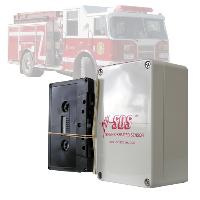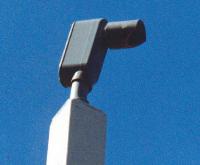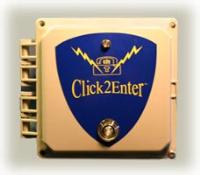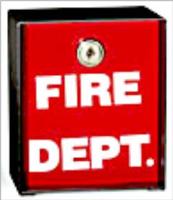Emergency Vehicle Entry System Siren Activated
OR Strobe Light OR Scanner Radio. We offer all three system including lock boxes
see them below
 The
SOS-YDT version stands for YELP/DECIBEL/TIME. It's programmed to respond to
emergency vehicle sirens' "YELP" and open the gate in 2.5 seconds. If the
responder is not using the "YELP", yet the decibel level remains high for an
additional 2 seconds, the YDT will trigger the gate to open. This version will
therefore respond to the "wail" or any consistent sound producing 4.5 seconds of
high decibel. The SOS-YDT is proximity adjustable, and has switchable safety
options built into the circuit board. The
SOS-YDT version stands for YELP/DECIBEL/TIME. It's programmed to respond to
emergency vehicle sirens' "YELP" and open the gate in 2.5 seconds. If the
responder is not using the "YELP", yet the decibel level remains high for an
additional 2 seconds, the YDT will trigger the gate to open. This version will
therefore respond to the "wail" or any consistent sound producing 4.5 seconds of
high decibel. The SOS-YDT is proximity adjustable, and has switchable safety
options built into the circuit board.
 The FIRE STROBE 2OOO signal is received optically by line of
sight. The range varies with the ambient light and intensity of the strobe
emitter. A typical range varies from 150 feet to 500 feet. The detector will not
allow false operation with unwanted signals from radio interference and/or
flashing headlights or loud sounds. The acquisition time from the emitter light
source to the discriminate module is approximately .5 seconds. The FIRE STROBE
2OOO is widely used for security /electric gate access. It can be used for
firehouse garage doors and other related access needed by emergency vehicles.
This emergency-vehicle strobe detector provides rapid access to any gated
community that has been serviced by fire and emergency equipment from the
OPTICOM* STROBE SYSTEM The FIRE STROBE 2OOO signal is received optically by line of
sight. The range varies with the ambient light and intensity of the strobe
emitter. A typical range varies from 150 feet to 500 feet. The detector will not
allow false operation with unwanted signals from radio interference and/or
flashing headlights or loud sounds. The acquisition time from the emitter light
source to the discriminate module is approximately .5 seconds. The FIRE STROBE
2OOO is widely used for security /electric gate access. It can be used for
firehouse garage doors and other related access needed by emergency vehicles.
This emergency-vehicle strobe detector provides rapid access to any gated
community that has been serviced by fire and emergency equipment from the
OPTICOM* STROBE SYSTEM
 Click2Enter taps the state-of-the-art electronics now
designed into modern scanner radio technology to give public safety personnel
(Law Enforcement, Fire, Ambulance/ Rescue or any authorized user) a quick, safe,
reliable and stealthy means to activate gates and security control mechanisms
using their portable or mobile radios. • Click2Enter does away with the
cumbersome keys, remote control actuators and access control codes required by
other systems because every emergency response vehicle already has the
“key”—their radio transmitter (mobile or portable). No need to buy extra
equipment or modify your radios. Click2Enter taps the state-of-the-art electronics now
designed into modern scanner radio technology to give public safety personnel
(Law Enforcement, Fire, Ambulance/ Rescue or any authorized user) a quick, safe,
reliable and stealthy means to activate gates and security control mechanisms
using their portable or mobile radios. • Click2Enter does away with the
cumbersome keys, remote control actuators and access control codes required by
other systems because every emergency response vehicle already has the
“key”—their radio transmitter (mobile or portable). No need to buy extra
equipment or modify your radios.
  
Lock
Boxes Fire Department Emergency Access Postal Boxes Knox KS-2 key switch
(not supplied)
Emergency Access
When an automated vehicular gate system is installed on
a property in general access applications, there must be a method to allow
emergency vehicles (fire, police, ambulance) access to the property without the
gate hindering their entry. The access system must allow for entry through the
vehicular gate under three different and unique situations:
The system is in service and under normal operation.
A power failure has occurred and battery powered
convenience open systems are employed.
A power failure has occurred and the convenience open
system has failed (dead or low charged battery).
Situation 1 -
Normal Operation
Under normal operation, there are
many devices that can be integrated with the vehicular gate system to allow
emergency vehicles access to the property. When any of these devices are
activated, the vehicular gate(s) is commanded to open and remains open until the
device is deactivated. Typically, the emergency vehicle access device will
by-pass the primary access control device (telephone entry system for example)
and is wired directly to the gate operator open input. Some of these
devices are listed below.
Click-2-Enter. This system consist of a special
radio receiver that allows Fire Departments, Police Departments and Ambulance
companies to open the access gates by using their two-way radio installed in
their trucks / cars.
Special Keys and Key Switches - With this system,
emergency vehicles each have a special access key that that activates an
emergency override key switch. These key switches are typically labeled FIRE
DEPT. and are installed in a location at the gate that is visible and easily
accessible.
Lock Boxes - Lock boxes are essentially the same as the
key switch option in that a special padlock (that only emergency vehicles have a
key too) is placed on the lock box to lock it shut. When the padlock is removed
(or cut off), the lock box automatically commands the gate to open and will hold
the gate open until the lock box is re-closed and locked. Lock boxes are
typically labeled FIRE DEPT. and are installed in a location that is easily
visible and easily accessible.
Siren Sensors - These devices detect the "yelp" mode
from an emergency vehicles siren. When the yelp is detected, the gate will open.
Strobe Light Sensors - These devices respond to the
flashing strobe light from the emergency vehicle. When the strobe light is
sensed, the gate will open.
Wireless Transmitters - Like garage door openers,
wireless transmitters open the gate from a distance of 75 to 100 feet. These
transmitters are specially encoded with a code that is unique to emergency
vehicles.
Because of the many different devices available, the
city building department should be consulted to determine which method of entry
is preferred by the local authorities.
Situation 2 -
Power Failure with Battery Powered Convenience Open
System
Many manufacturers of vehicular gate operators now offer battery
powered convenience open systems that provide a method to open the gate when
primary (AC) power is removed. DKS offers this type system in many of its gate
operator products. This type of system is completely self-contained in the
operator and is completely independent from the primary drive system. In
essence, this provides a redundant drive system when the primary AC power is
removed. Note: If your operator does not employ a battery back-up system,
please refer to situation 3 below.
Operators equipped with a battery powered convenience
open system typically operate in one of two different methods. 1) When a power
failure occurs, the system immediately commands the gate to open and remain
open, or 2) when a power failure occurs, the system remains in a stand-by mode
until a command from either a wireless transmitter or manual switch is received
to open the gate. In the second option, it is important to note that the
radio receiver is powered from the batteries which allow the receiver to remain
in operation during a power failure. This design feature assures that any
emergency vehicle using the wireless transmitter method of entry will be capable
of commanding the gate open even during power outages.
Battery powered convenience open systems in vehicular
gate operators provide a trickle charge to the batteries during normal
operation. It is advisable that maintenance personnel and property managers
check these systems on a monthly basis to assure that the batteries are in good
condition and have enough power to open the gate. Batteries in these systems are
good, on average, for about two years before they will need to be
replaced.
Situation 3 -
Power Failure and Battery Powered System Failure
This is the
"worst case" scenario that must be addressed during the design of the vehicular
gate access system. In other words, system designers and installers must assume
that at some point in time there will be a primary power failure and the battery
powered convenience open system will fail to open the gate because of dead or
low charged batteries or because of some other system component failure. Under
these circumstances, the gate operator must assume a FAIL-SAFE mode. Simply
stated, the operator "fails" in a safe condition allowing the gate to be
manually pushed open without the need for any keys, cranks, or other mechanical
devices. This is an essential feature for both emergency and non-emergency
vehicles. Obviously, emergency vehicle personnel cannot waste time looking for
keys, cranks, or attempting to force the gate open with bolt cutters, the "jaws
of life" or other mechanical devices. They also cannot wait for maintenance
personnel to arrive to activate gate release mechanisms that are typically
located on the inside of the gate. Likewise, apartment and gated communities
cannot allow a situation to develop where residents are "locked" out of their
homes. Many Fire Department regulations require that "fail-safe" gate
operators be installed to allow emergency vehicle access during power
outages.
Summary
Automatic vehicular gate systems
provide convenience and limit traffic in gated communities, apartment complexes,
condominiums, and private homes and businesses. When vehicular access is
restricted, there must be a means to allow emergency vehicles access in the
overall design of the system. This design must include failure modes under the
worst-case scenario, and the access system must have in place equipment and
products to over come the worst-case situation. DKS can provide you with
vehicular gate products that meet these requirements.
|

